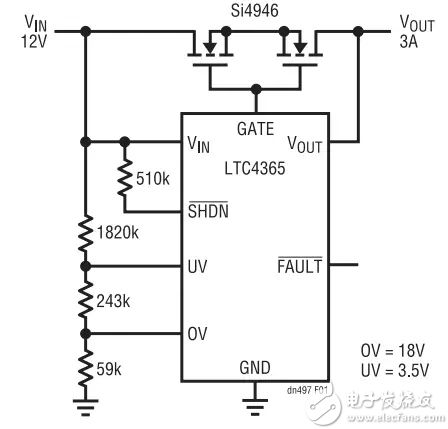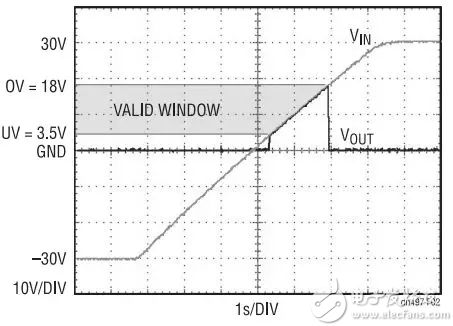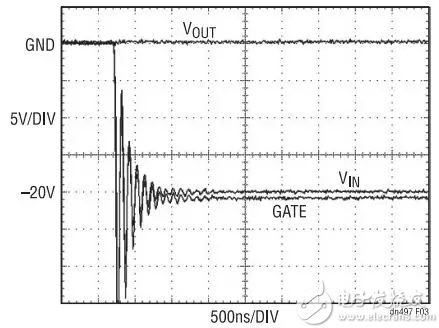What happens if someone connects a 24V power supply to your 12V circuit? If the power line and ground line are negligently reversed, can the circuit be safe? Does your application circuit work in the harsh environment where the input supply transients to very high or even below ground? Even if the above-mentioned events occur at a low probability, any one of them will completely damage the circuit board. To isolate the negative supply voltage, it is customary to route a power diode or P-channel MOSFET in series with the power supply. however-- Diodes consume valuable board space and consume large amounts of power at high load currents. ◠Although the power consumption of P-channel MOSFETs is lower than that of series diodes, the MOSFET and the required driver circuit will increase the cost. Both solutions sacrifice low power operation performance, especially series diodes. Moreover, neither method provides protection against excessive voltages - this protection requires more circuitry, including a high voltage window comparator and charge pump. Undervoltage, overvoltage, and power reverse protection The LTC4365 is a unique solution that can delicately and robustly protect sensitive circuits from unexpectedly high supply voltages or negative supply voltages. The LTC4365 can isolate positive voltages up to 60V and negative voltages as low as –40V. Only the voltage within the safe operating power range is delivered to the load. The only external active component required is a dual N-channel MOSFET connected between an unpredictable power supply and a sensitive load. Figure 1 shows a complete application circuit. A resistive divider sets the overvoltage (OV) and undervoltage (UV) trip points used to connect/disconnect the load to VIN. If the input power drifts out of this voltage window, the LTC4365 will quickly disconnect the load from the power supply. The dual N-channel MOSFETs isolate the positive and negative voltages at VIN. During standard operation, the LTC4365 provides an enhanced 8.4V for the gate of the external MOSFET. The LTC4365's effective operating range is as low as 2.5V up to 34V - OV and UV window can be within this range. For most applications, there is no need to set a protective clamp on VIN, further simplifying the board design. Accurate and fast overvoltage and undervoltage protection Two accurate (±1.5%) comparators in the LTC4365 are used to monitor overvoltage (OV) and undervoltage (UV) conditions on VIN. If the input voltage rises above the OV threshold or falls below the UV threshold, respectively, the gate of the external MOSFET will quickly turn off. The external resistive divider allows the user to select an input supply range that is compatible with the load on VOUT. In addition, the UV and OV inputs also have a very low leakage current (typically <1nA at 100°C), thus providing a large current value in an external resistive divider. Figure 2 shows the response of VIN in the circuit of Figure 1 when ramping up slowly from –30V to 30V. The UV and OV thresholds are set to 3.5V and 18V, respectively. When the supply voltage is within the 3.5V to 18V window, VOUT follows VIN. If this window is exceeded, the LTC4365 turns off the N-channel MOSFET and disconnects VOUT from VIN even when VIN is negative. Novel power reverse protection The LTC4365 uses a novel negative power protection circuit. When the LTC4365 detects a negative voltage on VIN, it quickly connects the GATE pin to VIN. There is no diode drop between the GATE and VIN voltages. When the gate of the external N-channel MOSFET is at the most negative potential (VIN), the leakage current from VOUT to VIN is very small. Figure 3 shows what happens when VIN is charged to -20V. Just before the connection, VIN, VOUT, and GATE start at ground potential. Due to the parasitic inductance of the VIN and GATE connections, the voltages on the VIN and GATE pins will change significantly below –20V. The external MOSFET must have a breakdown voltage specification that can safely withstand this overshoot. Obviously, the speed of the LTC4365 reverse protection circuit depends on how close the GATE pin follows VIN during negative voltage transients. On the scale shown, the waveforms of both are almost indistinguishable. Please note that providing reverse protection does not require additional external circuitry. There are more features! Reverse VIN Hot SwapTM control with AC isolation and VOUT power up In the event of an OV or UV fault (or when VIN goes negative), the input supply must return to a valid operating voltage window for at least 36ms to turn the external MOSFET back on. This will effectively isolate 50Hz and 60Hz un-rectified AC power. In addition, the LTC4365 also provides protection against negative VIN connections even when VOUT is driven from a separate power supply. As long as the breakdown voltage (60V) of the external MOSFET is not exceeded, the polarity reversal at VIN will not affect the 20V supply on VOUT. in conclusion By using back-to-back MOSFETs (without using diodes), the LTC4365 controller provides overvoltage, undervoltage, and power supply reverse protection for sensitive circuits. The supply voltage can only be delivered to the output if it passes the user-adjustable UV and OV trip thresholds. Any voltage that exceeds this window is isolated and the protection range can be as high as 60V and as low as –40V. The LTC4365's novel rack architecture has a rugged, small form factor solution with few external components and is available in tiny 8-pin 3mm x 2mm DFN and TSOT-23 packages. The LTC4365 has a wide 2.5V to 34V operating range and consumes only 10μA during shutdown.
Silicone Rubber keypads (also known as elastomeric keypads) are used extensively in both consumer and industrial electronic products as a low cost and reliable switching solution.
Silicone rubber refers to the main chain is composed of silicon and oxygen atoms alternately; silicon atoms are usually connected with two organic groups of rubber. Ordinary silicone rubber consists mainly of a silico-oxygen chain with methyl and a small amount of vinyl. The introduction of phenyl can improve the high and low temperature resistance of silicone rubber, and the introduction of trifluoro propyl and cyanide can improve the temperature and oil resistance of silicone rubber. Silicone rubber has good low temperature resistance and can still work at -55℃. After the introduction of phenyl, -73℃ can be reached. The heat resistance of silicone rubber is also very prominent, can work for a long time at 180℃, slightly higher than 200℃ can also withstand a few weeks or longer time is still elastic, instantaneous resistance to high temperature above 300℃. Silicone rubber has good air permeability and oxygen permeability is the highest in synthetic polymers. In addition, silicone rubber also has the outstanding characteristics of physiological inertia, will not cause clotting, so it is widely used in the medical field.
Silicone Rubber Keypads,Membrane Keyboard Switch,Silicone Rubber Waterproof Keypads,Silicone Rubber Numeric Keypad KEDA MEMBRANE TECHNOLOGY CO., LTD , https://www.kedamembrane.com Figure 1: Complete 12V automotive undervoltage, overvoltage and power reverse protection circuits
Figure 1: Complete 12V automotive undervoltage, overvoltage and power reverse protection circuits  Figure 2: Load protection when VIN rises from –30V to 30V
Figure 2: Load protection when VIN rises from –30V to 30V  Figure 3: Hot-Swap Protection from VIN to -20V
Figure 3: Hot-Swap Protection from VIN to -20V